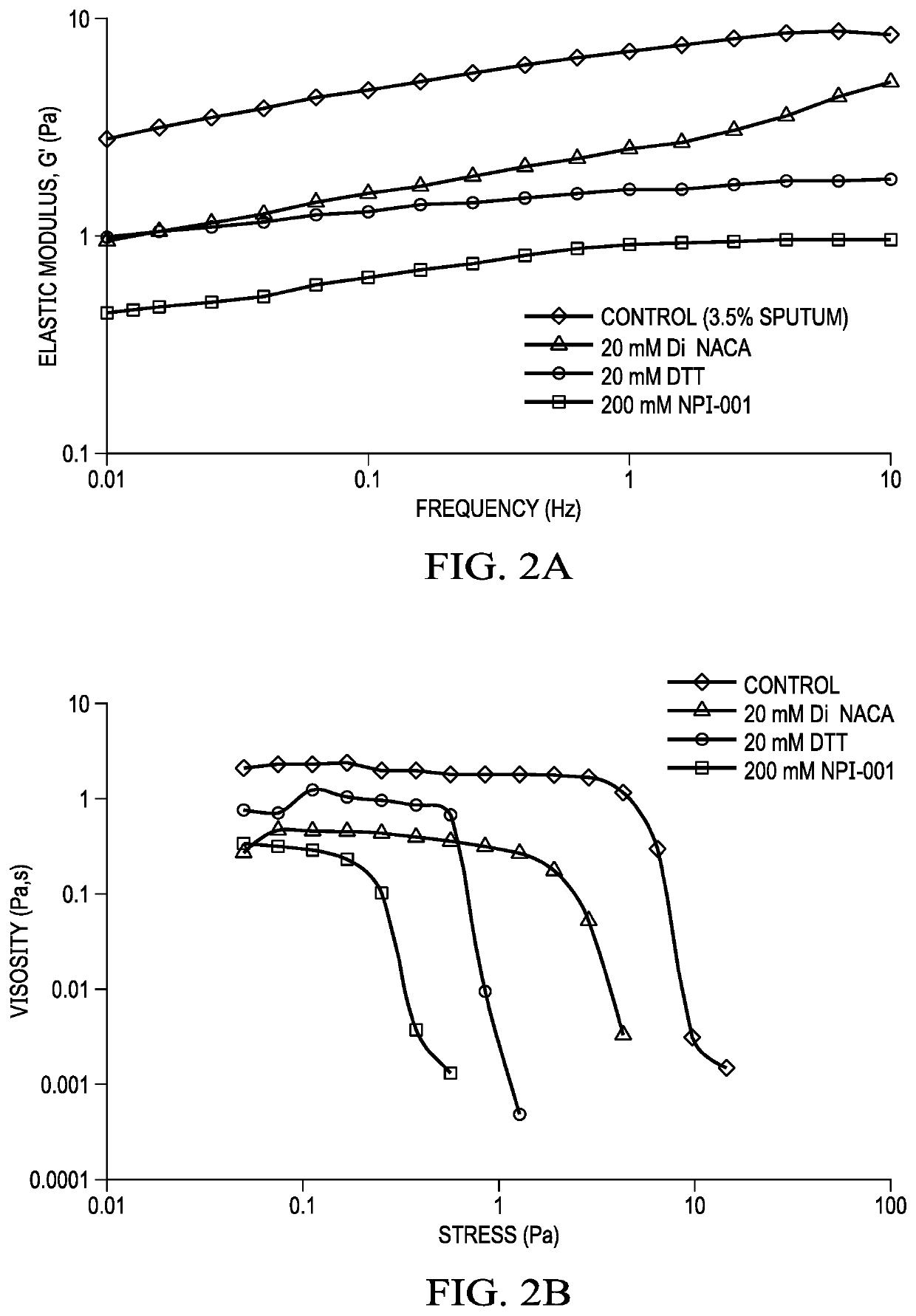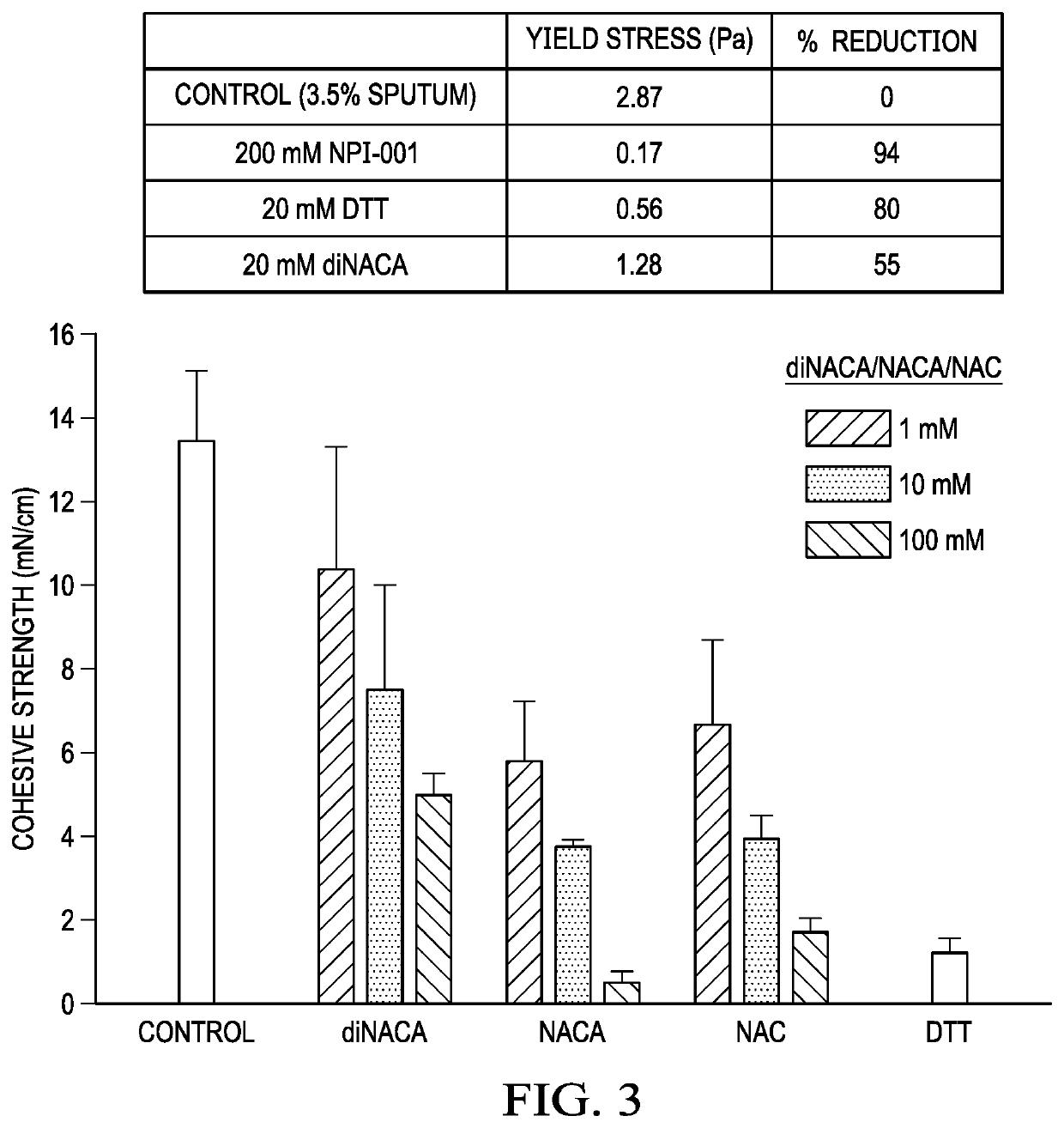N-Acetylcysteine Amide (NACA) and (2R,2R')-3,3' disulfanediyl BIS(2-Acetamidopropanamide) (DINACA) for the Prevention and Treatment of Radiation Pneumonitis and Treatment of Pulmonary Function in Cystic Fibrosis
a technology of disulfanediyl bis and acetylcysteine, which is applied in the direction of pharmaceutical active ingredients, medical preparations, drug compositions, etc., can solve the problems of no established treatment for radiation pneumonitis, achieve the effects of reducing mucus viscosity, elasticity and/or cohesion, and preventing age-related macular degeneration
- Summary
- Abstract
- Description
- Claims
- Application Information
AI Technical Summary
Benefits of technology
Problems solved by technology
Method used
Image
Examples
example 1
ACA and DTT Effects on Human Bronchial Epithelial (HBE) Airway Mucus
[0063]Mucus obstruction in the airway is a pathway of considerable interest, given that this is one of the primary areas that can cause the lung to fail. It is well established that highly concentered mucus associated with diseases such as CF and COPD is not effectively or efficiently cleared by the human lung, leading to a host of respiratory complications. One potential method of restoring optimal mucus clearance is to use a powerful mucolytic agent to effectively breakdown the mucus into more easily cleared particle sizes.
[0064]In the Example 1, the inventors assessed the ability of NACA to reduce the rheological properties of a concentrated (cystic fibrosis-like) mucus, making it more flowable. In this phase, NACA was compared to both a classical clinical reducing agent (N-acetylcysteine; NAC) as well as a potent laboratory reducing agent (Dithiothreitol; DTT). The studies in this phase of the project were perfo...
example 2
f NACA, diNACA and DTT on Human CF Sputum
[0072]Human CF sputum was collected. Reducing agents such as NACA, diNACA and DTT should reduce the viscosity of sputum. Elastic modulus was assessed for NACA, diNACA, compared to positive control, DTT. The concentration of human CF sputum was 3.5% in all samples. Sample preparation:
[0073]20 mM diNACA was prepared directly by adding powder to sputum
[0074]20 mM DTT and 200 mM NACA were prepared by spiking sputum with solutions of each reducing agent in saline. Elastic modulus and creep recovery (yield stress (viscosity)) was measured using a rheometer.
[0075]FIG. 2A shows a frequency sweep of NACA, diNACA and DTT in human CF sputum, and FIG. 2B shows the creep recovery or yield stress (viscosity) of human CF sputum after pretreatment with NACA, diNACA or DTT.
[0076]FIG. 3 is a graph that shows cohesion of NACA, diNACA and DTT in human CF sputum. FIG. 4 is a graph that shows cohesion of NACA, diNACA and DTT in human CF sputum. FIG. 5 is a graph t...
PUM
| Property | Measurement | Unit |
|---|---|---|
| molecular weight | aaaaa | aaaaa |
| molecular weight | aaaaa | aaaaa |
| molecular weight | aaaaa | aaaaa |
Abstract
Description
Claims
Application Information
 Login to View More
Login to View More - R&D
- Intellectual Property
- Life Sciences
- Materials
- Tech Scout
- Unparalleled Data Quality
- Higher Quality Content
- 60% Fewer Hallucinations
Browse by: Latest US Patents, China's latest patents, Technical Efficacy Thesaurus, Application Domain, Technology Topic, Popular Technical Reports.
© 2025 PatSnap. All rights reserved.Legal|Privacy policy|Modern Slavery Act Transparency Statement|Sitemap|About US| Contact US: help@patsnap.com



